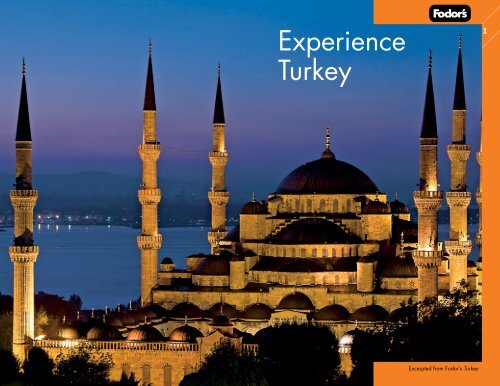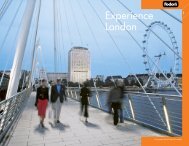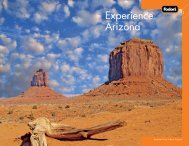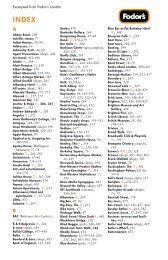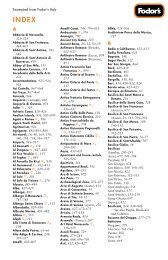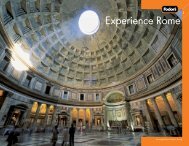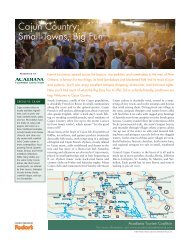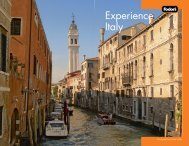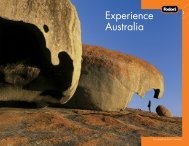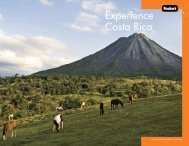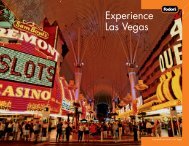Experience Turkey - Fodor's
Experience Turkey - Fodor's
Experience Turkey - Fodor's
Create successful ePaper yourself
Turn your PDF publications into a flip-book with our unique Google optimized e-Paper software.
<strong>Experience</strong><br />
<strong>Turkey</strong><br />
Excerpted from Fodor’s <strong>Turkey</strong><br />
1
10 < <strong>Experience</strong> <strong>Turkey</strong><br />
WHAT’S<br />
WHERE<br />
The following numbers refer to<br />
chapters.<br />
2 Istanbul. Straddling<br />
Europe and Asia, Istanbul is<br />
the undisputed cultural, economic,<br />
and historical capital<br />
of <strong>Turkey</strong>. There are enough<br />
monuments and attractions,<br />
as well as enticing restaurants,<br />
shops, and museums to<br />
keep you busy for days.<br />
3 The Sea of Marmara and<br />
the North Aegean. The battlefields<br />
of Gallipoli are one<br />
of the main reasons travelers<br />
visit this part of <strong>Turkey</strong>, but<br />
the area is also a destination<br />
for beach lovers and those<br />
looking for pleasant places to<br />
hike. The archaeological site<br />
of ancient Troy is here, too.<br />
4 The Central and Southern<br />
Aegean Coast. The heart<br />
of what was once known by<br />
the ancient Greeks as Asia<br />
Minor, this area has been<br />
drawing visitors since the time<br />
of, well, Homer. The heavyweight<br />
attraction these days is<br />
the Roman city of Ephesus but<br />
there are also many beach<br />
destinations, ranging from<br />
glitzy to relaxed.<br />
5 The Turquoise Riviera.<br />
The beaches along <strong>Turkey</strong>’s<br />
southern shores—dubbed<br />
the Turquoise Riviera—<br />
are some of the best in<br />
the country, and the ruins<br />
here are spectacular. With<br />
unspoiled seaside villages<br />
and charming hotels and<br />
pansiyons, this is very close<br />
to paradise. Steer clear of<br />
the megaresorts though,<br />
which have started to<br />
invade, particularly around<br />
Antalya.<br />
6 Cappadocia, Ankara and<br />
the Turkish Heartland. In<br />
magical Cappadocia, wind<br />
and rain have shaped soft<br />
volcanic rock into a fairy-tale<br />
landscape, where conical<br />
outcroppings were centuries<br />
ago turned into churches and<br />
homes. Southwest of Cappadocia<br />
is Konya, home to a<br />
museum and tomb dedicated<br />
to the 13th-century founder of<br />
the whirling dervishes. Ankara,<br />
<strong>Turkey</strong>’s capital, is also here,<br />
though it ranks fairly low on<br />
most visitors’ itineraries.<br />
7 The Far East and Black<br />
Sea Coast. It may not have<br />
the resorts, boutique hotels,<br />
and upscale restaurants of<br />
western <strong>Turkey</strong>, but there are<br />
impressive sites—both natural<br />
and manmade—to be<br />
found, including picturesque<br />
mountain villages; historic<br />
monasteries; the ancient<br />
city of Ani and towering<br />
Mt. Ararat; and fascinating<br />
Nemrut Dağı. In all these<br />
places, you’re certain to get<br />
a taste of a different and<br />
rewarding <strong>Turkey</strong>.<br />
What’s Where<br />
> 11
12 < <strong>Experience</strong> <strong>Turkey</strong><br />
TURKEY TODAY<br />
Politics<br />
In July 2007, Turks, in overwhelming<br />
numbers, reelected the Justice and Development<br />
Party (AKP). This led to Abdullah<br />
Gul’s ascension as president, where he<br />
joined fellow-conservative Prime Minister<br />
Recep Tayyip Erdogan to govern the country.<br />
In Istanbul, die-hard secularists have<br />
been alarmed by AKP’s increasing power<br />
and continue to assert that the party<br />
seeks to erode the secular legacy of Mustafa<br />
Kemal Atatürk. Some even contend<br />
that the AKP seeks to impose Sharia law<br />
(strict Islamic day-to-day religious law)<br />
on the country, though party leadership<br />
vehemently denies such aims. Secularists<br />
point to laws limiting the sale of alcohol,<br />
tobacco, pornography, and pork as well<br />
as a 2007 law to lift the constitutional ban<br />
on headscarves at universities.<br />
<strong>Turkey</strong>’s biggest foreign policy goal continues<br />
to be accession to the European<br />
Union. Most member states are in favor<br />
of <strong>Turkey</strong> joining, though there are some<br />
strong opponents, and accession talks<br />
have made only halting progress as <strong>Turkey</strong><br />
faces criticism on several issues. Continued<br />
Turkish occupation of Northern<br />
Cyprus (which only <strong>Turkey</strong> recognizes<br />
as a sovereign nation) is one stumbling<br />
block, another is the Turkish government’s<br />
refusal to label the death of several<br />
hundred thousand Armenian citizens<br />
during World War I as genocide. Domestically,<br />
critics cite <strong>Turkey</strong>’s headscarf ban<br />
and criminal laws that punish anyone<br />
found guilt of insulting “Turkishness” as<br />
undemocratic as further obstructions.<br />
The Economy<br />
The AKP’s greatest bargaining chip in<br />
recent elections was the upsurge of the<br />
Turkish economy since the aftermath of<br />
the 1999 earthquake. The country enjoys<br />
a diverse economy: self-sufficient agricultural<br />
production, a massive textile industry,<br />
and a growing electronics sector.<br />
Turkish annual GDP growth this decade,<br />
at 7.4% per year, is among the fastest in<br />
the world. The rest of the world has taken<br />
a greater interest in <strong>Turkey</strong> in the past 10<br />
years, as evidenced by the consistent 10%<br />
growth rate of the tourist industry. International<br />
faith in the economy has driven<br />
considerable foreign investment, which<br />
has strengthened the Turkish Lira. Inflation,<br />
which for 30 years led to the counting<br />
of the Lira in millions, has dropped<br />
to single digit levels and allowed the government<br />
to lop six zeroes from the old<br />
Lira in 2005. <strong>Turkey</strong>’s greatest economic<br />
liability is a sizable trade deficit, driven<br />
largely by the country’s need to import<br />
foreign oil. Until the 2008 credit crunch,<br />
however, foreign investment more than<br />
compensated for these deficits.<br />
Religion<br />
In Istanbul they sell a T-shirt with the<br />
name of the city spelled using a crescent,<br />
a cross, and a Star of David. Turks pride<br />
themselves on their secularism and tolerance<br />
of other religions, a legacy of the<br />
Ottoman Empire, which governed people<br />
of all faiths. While <strong>Turkey</strong> is a secular<br />
republic, however, its population is overwhelming<br />
(99%) comprised of Muslims;<br />
the remaining 1% are Christians (Greek<br />
Orthodox and Armenian Apostolic) and<br />
Jews. One reason for the relative harmony<br />
between people of different faiths<br />
may be the relaxed approach that many<br />
Turks take toward religion. In addition<br />
to having a secular government, many<br />
Turks drink alcohol and smoke cigarettes,<br />
and on any given day in Istanbul<br />
you are as liable to find as many scantily<br />
clad fashionistas walking down the street<br />
as women wearing headscarves.<br />
The Arts<br />
<strong>Turkey</strong> has made many recent contributions<br />
to the art world—no surprise<br />
from a country that boasts such stunning<br />
antiquity—and Istanbul has been chosen<br />
as the 2010 European Capital of Culture.<br />
The country’s most well-known creative<br />
mind may be novelist Orhan Pamuk, who<br />
garnered the country’s first Nobel Prize<br />
in 2006 for his dreamy yet historic novels,<br />
but the Istanbul Film Festival is currently<br />
in its 26th year: held every April,<br />
the festival awards prizes for both Turkish<br />
and International films. Additionally, <strong>Turkey</strong>’s<br />
status as a large textile exporter has<br />
helped ensure the nation a place in fashion<br />
design, and Istanbul’s Nişantaşı district is<br />
literally a maze of small boutiques selling<br />
imported and Turkish clothing. In the<br />
visual arts, <strong>Turkey</strong> is most famous for its<br />
ceramics and porcelain, especially handmade<br />
Kütahya and İznik tiles.<br />
Sports<br />
<strong>Turkey</strong> is a die-hard soccer nation (they<br />
call it football), and heated rivalries run<br />
strong. <strong>Turkey</strong>’s clubs boast lots of homegrown<br />
talent along with some players<br />
imported from Europe and South America.<br />
The Turkish national football team<br />
has enjoyed sporadic success in international<br />
play. In this decade, the team<br />
reached the semifinals in the 2002 World<br />
Cup and 2008 European Cup. Other popular<br />
sports in <strong>Turkey</strong> are basketball (the<br />
NBA has a growing fan base in <strong>Turkey</strong>)<br />
and Turkish Grease Wrestling. Edirne is<br />
famous for its annual Kırkpinar oil wrestling<br />
festival.<br />
<strong>Turkey</strong> Today > 13<br />
Media<br />
Turkish media seems always to be on<br />
people’s lips, mainly because of Article<br />
301 and the Turkish government’s penchant<br />
for closing down outlets that offend<br />
its conservative moral code. Article 301<br />
forbids anyone from insulting “Turkishness,”<br />
under pain of criminal prosecution.<br />
Most cases are dropped but many<br />
notable Turks, including Orhan Pamuk,<br />
have been prosecuted. Another issue was<br />
the 2007 shutdown of the popular video<br />
site YouTube after the government discovered<br />
videos insulting Atatürk. Despite<br />
these controversies, freedom of speech is<br />
mostly unlimited in <strong>Turkey</strong> and writers<br />
and journalists can criticize the government<br />
and people as long as they don’t<br />
cross the line to insult.<br />
Smoking<br />
In an effort to curb rampant tobacco<br />
addiction, the Turkish government introduced<br />
a ban on smoking in enclosed public<br />
places, which took effect in May of<br />
2008. Some bars and clubs simply ignore<br />
the ban, but the Turkish Health Ministry<br />
estimates that Turks are smoking 500 million<br />
fewer cigarettes per month.<br />
And Looking Forward . . .<br />
2009 marks the return of the Rock N’<br />
Coke music festival after a hiatus in 2008.<br />
This is <strong>Turkey</strong>’s largest music festival<br />
attracts big names in local and international<br />
music; the 2007 festival drew Franz<br />
Ferdinand and Smashing Pumpkins. 2010<br />
will also be a proud year for <strong>Turkey</strong>, since<br />
Istanbul has been chosen as the European<br />
Capital of Culture for the year. The Turkish<br />
government sees this as an opportunity<br />
to showcase Istanbul’s wealth of art, culture,<br />
and history to the rest of the world.
14 < <strong>Experience</strong> <strong>Turkey</strong><br />
TURKEY<br />
PLANNER<br />
When to Go<br />
Most tourists visit <strong>Turkey</strong> between<br />
April and the end of<br />
October. July and August are<br />
the busiest and hottest months.<br />
April through June and September<br />
to October offer more temperate<br />
weather, and crowds are<br />
smaller.<br />
Istanbul tends to be hot in summer,<br />
cold and rainy in winter. The<br />
Mediterranean (Turquoise) and<br />
Aegean coasts have mild winters<br />
and hot summers; you can<br />
swim along either coast from<br />
late April into October. The Black<br />
Sea coast is mild and damp, with<br />
a rainfall of 90 inches per year.<br />
Central and eastern Anatolia<br />
can be extremely cold in winter,<br />
with roads and mountain<br />
passes closed by snow; summers<br />
bring hot, dry weather,<br />
but cool evenings.<br />
86<br />
68<br />
50<br />
32<br />
0<br />
14<br />
J F M A M J J A S O N<br />
-10<br />
D<br />
86<br />
68<br />
50<br />
32<br />
0<br />
J F M A M J J A S O N D<br />
30<br />
20<br />
10<br />
30<br />
20<br />
10<br />
Getting Around<br />
In <strong>Turkey</strong> you can travel by plane, car, bus, or train. With<br />
the advent of several new domestic airline companies in<br />
recent years, competition has increased and the cost of<br />
domestic flights has come down, so if your aim is to see<br />
several different areas of the country in a short time, you<br />
may want to fly between destinations.<br />
<strong>Turkey</strong> has an extensive bus network, with buses serving all<br />
the major cities and even the smallest towns. Buses are generally<br />
safe, reliable, and surprisingly comfortable, making<br />
them an excellent way to travel around the country.<br />
Renting a car allows you greater flexibility than traveling<br />
by bus, and the chance to see to places that are more off<br />
the beaten path, as well a glimpse of small-town Turkish<br />
life. Although major roads are generally in good condition,<br />
minor roads can be rough and badly paved, and it’s wise<br />
to avoid driving at night. If you don’t want a stick shift, reserve<br />
well in advance and specify automatic transmission.<br />
Although cheaper than buses, trains tend to be far slower<br />
and do not serve many areas of the country. A high-speed<br />
rail line between Istanbul and Ankara is set to open in<br />
2009 or 2010, but for other routes it’s not usually worth<br />
taking the train.<br />
For more detailed information, see the Travel Smart chapter<br />
and the specific regional chapters.<br />
What to Pack<br />
For women, it’s advisable to bring a scarf or shawl that<br />
will cover the hair (and shoulders, if you are wearing a<br />
sleeveless shirt) so as to dress appropriately when entering<br />
mosques. If you’re planning to visit Cappadocia, a flashlight<br />
can be extremely useful for exploring cave churches<br />
and underground cities. If you’re going anywhere with<br />
beaches or archaeological ruins, it’s wise to have sunscreen,<br />
as the Turkish sun can be intense. An umbrella is a<br />
good idea if you’re visiting Istanbul during the rainy winter<br />
months.<br />
Hotels in <strong>Turkey</strong><br />
<strong>Turkey</strong> has a variety of different types of accommodation,<br />
from simple inns to boutique hotels and luxury international<br />
chains. Pansiyons, found especially throughout the coastal<br />
areas and in small towns, tend to be small, family-run, and<br />
offer inexpensive but clean lodgings, usually with a typical<br />
Turkish breakfast included. The designation of “special-class<br />
hotels” includes restored Ottoman mansions and villas,<br />
cave hotels in Cappadocia, and other establishments with<br />
unique historic, cultural, and/or architectural character.<br />
Hotels in <strong>Turkey</strong> are officially classified as HL (Luxury) and<br />
H1 to H5 (first- to fifth-class). These designations can be<br />
misleading though, as they’re based on quantity of facilities<br />
rather than the quality of the service and decor, and<br />
a lack of restaurant or lounge automatically relegates the<br />
establishment to the bottom of the ratings. In reality, a<br />
lower-grade hotel may actually be far more charming and<br />
comfortable than one with a higher rating.<br />
Restaurants in <strong>Turkey</strong><br />
<strong>Turkey</strong> has restaurants to suit your every mood and budget.<br />
Bufe. These are great for cheap and simple döners—meat<br />
grilled on a vertical spit—or tost, a panini-like grilled<br />
cheese sandwich.<br />
Lokanta. This name is given to a range of traditional restaurants<br />
that serve homey dishes like soups, stews, and casseroles.<br />
Most lokantalar offer a variety of fresh food that’s<br />
displayed in long steam tables. Point to what looks good<br />
and a waiter will bring it to your table.<br />
Meyhane. Tavern-like meyhanes are the place to go for<br />
meze, to drink raki, and perhaps sing the night away with<br />
your fellow diners. Meyhanes usually also serve fish.<br />
Balıkci. Balık means “fish” in Turkish, and seafood restaurants<br />
tend to be more sedate than meyhanes. Though they<br />
serve many of the same mezes as meyhanes, these restaurants<br />
will have a larger selection of fish and more creative<br />
ways to cook them.<br />
Kebabci. Kebab restaurants usually stick to the basics:<br />
skewered meat (usually a selection of lamb, beef, and<br />
chicken) served sizzling off the grill, and a few side dishes.<br />
Muhallebi/Pastane. Indulging your sweet tooth isn’t a problem<br />
in <strong>Turkey</strong>. Muhallebis specialize in milk-based desserts<br />
like sutlac, a rich rice pudding. Pastanes have Europeanstyle<br />
cakes and cookies.<br />
<strong>Turkey</strong> Planner<br />
Mosque Etiquette<br />
> 15<br />
The Turks are quite lenient<br />
about tourists visiting mosques<br />
and most are open to the public<br />
during the day, but there are<br />
some rules of etiquette:<br />
It’s best not to enter a mosque<br />
during the five daily prayer sessions,<br />
or at midday on Fridays,<br />
when attendances are higher—<br />
it’s sort of the equivalent of<br />
Sunday morning for Christians<br />
or Saturday morning for Jews.<br />
Immodest clothing is not allowed<br />
but an attendant by the<br />
door will lend you a robe if he<br />
feels you aren’t dressed appropriately.<br />
For women, bare arms<br />
and legs aren’t acceptable, and<br />
men should also avoid wearing<br />
shorts. Women should cover<br />
their heads before entering a<br />
mosque, though this is sometimes<br />
overlooked.<br />
Shoes must be removed before<br />
entering a mosque; there’s usually<br />
an attendant who watches<br />
over them. If you’re uncomfortable<br />
leaving your shoes,<br />
put them in your backpack or<br />
handbag.<br />
It’s considered offensive for a<br />
non-Muslim to sit down in a<br />
mosque (though you may see<br />
tourists who do, despite signs<br />
requesting them not to).<br />
Don’t take photographs inside<br />
the mosque, particularly of<br />
people praying.<br />
A small donation is usually requested<br />
for the upkeep of the<br />
mosque. The equivalent of approximately<br />
$3 is appropriate.<br />
1
16 < <strong>Experience</strong> <strong>Turkey</strong><br />
TURKEY<br />
TOP ATTRACTIONS<br />
A D G<br />
H<br />
Edirne<br />
(A) Edirne is home to the undisputed<br />
masterpiece of Ottoman architecture, the<br />
Selimiye Mosque, built by the architect<br />
Sinan in 1574. A former Ottoman capital,<br />
the Sultans gave Edirne a rich collection of<br />
architecture, which can be enjoyed in the<br />
relaxed atmosphere of this leafy provincial<br />
center. Edirne is also home to <strong>Turkey</strong>’s<br />
annual Grease Wrestling tournament.<br />
Aya Sofya<br />
(B) Aya Sofya was, for nearly a thousand<br />
years, the greatest church in Christendom.<br />
Built by the emperor Justinian in the 6th<br />
century, it’s one the few buildings of this<br />
age, size, and grandeur to survive today.<br />
Its giant dome shelters numerous historic<br />
artworks, from Byzantine mosaics to<br />
Islamic calligraphy.<br />
Yerebatan Sarnicı<br />
(C) Dark basements with serious damp<br />
problems aren’t normally tourist attractions,<br />
unless they happen to be evocative<br />
B C E<br />
F<br />
Byzantine cisterns, held up by ancient columns<br />
that are reflected in water teaming<br />
with fish. Built 1,500 years ago to preserve<br />
the city’s water supply through siege<br />
and drought, it’s a peaceful, surreal escape<br />
from the heat of an Istanbul summer.<br />
The Blue Mosque<br />
(D) Elegant, cascading curves and a central<br />
location make the Blue Mosque (aka<br />
Sultan Ahmet Camii), the most famous<br />
mosque in Istanbul. Inside is a spectacular<br />
coating of blue İznik tiles, which give<br />
it its nickname.<br />
Ephesus<br />
(E) Ephesus was the metropolis of Asia and<br />
archaeologists have revealed a treasure<br />
trove of ancient streets once walked by<br />
Alexander the Great and St. Paul. There<br />
are houses, theaters, temples, toilets, even<br />
a brothel, and the columned facade of the<br />
Library of Celsus.<br />
Topkapı Sarayı<br />
Topkapı Palace was the home of the Ottoman<br />
Sultans and the heart of the empire.<br />
Its grassy courtyards once buzzed with the<br />
comings and goings of soldiers, ambassadors,<br />
eunuchs, and Pashas, while in the<br />
private chambers of the Harem, dripping<br />
with lovely blue tiles, the Sultan’s women<br />
schemed to bring a son to the throne.<br />
Former storerooms overflow with gold<br />
thrones, gigantic diamonds, and the holiest<br />
relics of Islam.<br />
Göreme Open-air Museum<br />
(F) The unique lunar landscape of Cappadocia<br />
is honeycombed with Byzantine<br />
churches cut from the rock in the Middle<br />
Ages, many decorated with beautiful<br />
frescoes. The most famous and easily<br />
accessible place to visit is the collection<br />
of churches and dwellings known as the<br />
Göreme Open-air Museum.<br />
<strong>Turkey</strong> Top Attractions<br />
> 17<br />
Pamukkale<br />
(G) Stunning white travertine pools of<br />
water cascade down a hillside in the hinterland<br />
of the Aegean coast: this unique<br />
rock formation was created over eons by<br />
mineral-rich water and has attracted tourists<br />
for millenia.<br />
Mt. Nemrut<br />
(H) Atop a lonely mountain overlooking<br />
the Euphrates, this ancient shrine to the<br />
megalomania of one man is an extraordinary<br />
archaeological site. The oversize<br />
heads of King Antiochos and his fellow<br />
gods litter the ground beside a great burial<br />
mound.<br />
Olympos<br />
These jungle-entangled ruins in a valley by<br />
one of the Mediterranean’s most beautiful<br />
beaches are overlooked by the natural<br />
eternal flame of the Chimaera. Few places<br />
combine <strong>Turkey</strong>’s many attractions as<br />
does Olympos.<br />
1
18 < <strong>Experience</strong> <strong>Turkey</strong><br />
TOP TURKEY<br />
EXPERIENCES<br />
Take a Boat up the Bosphorus<br />
A boat ride along the Bosphorus is one of<br />
the most enjoyable ways to see the sprawling,<br />
magnificent city of Istanbul. From the<br />
ferry’s vantage point, you’ll see landmarks<br />
like the Dolmabahçe and Çırağan Palaces;<br />
Ortaköy Mosque, perched right on the<br />
water’s edge; and exquisite waterfront<br />
mansions, called yalıs, that were summer<br />
homes for the Ottoman elite. You’ll also<br />
pass under the waterway’s two suspension<br />
bridges, which connect Asia and Europe.<br />
While onboard, sip a glass of Turkish tea<br />
and listen to the calls of the seagulls as<br />
you contemplate this beautiful meeting of<br />
two continents.<br />
Scrub Down in a Turkish Bath<br />
Before the era of indoor plumbing, going<br />
to a hamam, or public bath, was a central<br />
element of Turkish life. Today many beautiful<br />
centuries-old hamams are still in use,<br />
by both locals and tourists. Most have<br />
separate facilities for men and women. In<br />
the hamam’s steam room, you can relax<br />
on the heated marble platform in the center<br />
and rinse yourself at one of the marble<br />
washbasins. If you choose, you’ll also be<br />
lathered, scrubbed, and massaged by a<br />
hamam attendant, whose goal seems to<br />
be to remove every last dry skin cell from<br />
the surface of your body. You’ll emerge<br />
ultra-clean, refreshed, and having taken<br />
part in an age-old Turkish tradition.<br />
Stay in a Cave Hotel<br />
Where but in Cappadocia can you sleep<br />
like the Flintstones while having all of<br />
your creature comforts? While few of<br />
Cappadocia’s inhabitants still live in traditional<br />
homes carved out of the soft tufa<br />
stone, in recent years the area’s hoteliers<br />
have been converting more and more of<br />
these “cave” dwellings into hotels, which<br />
range from basic inns for backpackers<br />
to upscale lodgings with plush furnishings,<br />
modern lighting, and fully equipped<br />
bathrooms, some even with Jacuzzis. Surrounded<br />
by Cappadocia’s magical landscape,<br />
tucked cozily into your cave room<br />
at night, you’ll feel almost like you’re on<br />
another planet.<br />
Watch the Dervishes Whirl<br />
<strong>Turkey</strong> is famous for its “whirling dervishes,”<br />
a sect of Sufi mystics, the Mevlevi,<br />
who believe that ritual spinning in circles<br />
will bring them to union with God. This<br />
trance-like whirling is just one element<br />
of the sema, a highly symbolic religious<br />
ceremony that also includes music and<br />
Koranic recitation. Despite the fact that<br />
these dervish ceremonies have become<br />
increasingly tourist-oriented in recent<br />
years, attending a sema is still a powerful<br />
and mesmerizing experience. Seeing the<br />
dervishes whirl is one of the main draws<br />
of the festival commemorating Rumi in<br />
Konya each December; there are also regular<br />
dervish performances in Istanbul and<br />
elsewhere in <strong>Turkey</strong>.<br />
Take a Blue Cruise<br />
One of the most popular and relaxing<br />
ways to experience <strong>Turkey</strong>’s Aegean and<br />
Mediterranean coasts is to take a Blue<br />
Cruise aboard a gulet, or wooden fishing<br />
vessel. Usually lasting several days (or longer),<br />
these cruises take passengers along<br />
the rugged coastline, with stops to visit<br />
ruins or villages. Away from the beach<br />
crowds, you’ll enjoy the simple pleasures<br />
of swimming in remote coves, eating fresh<br />
caught fish, and sleeping on your boat in<br />
a wooded inlet.<br />
Quench Your Thirst Like the Locals<br />
A trip to <strong>Turkey</strong> isn’t complete without<br />
sampling certain quintessentially Turkish<br />
beverages. You can barely go anywhere<br />
without being offered a glass of çay, or<br />
tea: the lubricant for every social and business<br />
encounter, it’s consumed in <strong>Turkey</strong> at<br />
one of the world’s highest rates per capita.<br />
The famous Turkish coffee, a thick brew<br />
made with extremely finely ground coffee<br />
beans, is in fact drunk far less often: primarily<br />
just on special occasions and as a<br />
digestive after meals. For something cold,<br />
try the ubiquitous ayran, a frothy, salted,<br />
yogurt drink that’s a refreshing accompaniment<br />
to a spicy meal of kebabs. Another<br />
unique beverage is sahlep, a sweet, milkbased<br />
hot drink served during the winter<br />
months. And don’t forget to taste the<br />
anise-flavored national liquor rakı.<br />
See Cappadocia from Above<br />
Taking a trip in a hot-air balloon is a<br />
thrilling way to see the amazing scenery<br />
of Cappadocia; for many people this is<br />
the highlight of their trip to the area. As<br />
your balloon follows the natural contours<br />
of the terrain, you’ll look down into scenic<br />
valleys and sail right past “fairy chimneys”<br />
and unusual rock formations that<br />
seem almost close enough to touch. Flights<br />
leave at dawn, when the air is calmest and<br />
safest for flying, and end with a champagne<br />
toast.<br />
Wander Among Ruins<br />
With so many civilizations having occupied<br />
the land that is now <strong>Turkey</strong>, it’s no<br />
surprise that the country is sprinkled with<br />
ancient ruins. The remains of Roman and<br />
Greek cities, with their impressive theaters,<br />
temples, stadiums, and colonnaded<br />
streets compete with even older sites dating<br />
back to the Hittites. From beachside<br />
Patara and Olympos, to Termessos high<br />
up in the mountains, to the inland Aphrodisias,<br />
each spot is uniquely picturesque.<br />
At the best-preserved sites like Ephesus<br />
and Troy, you’ll be among many visitors<br />
marveling at the ruins, but at places that<br />
Top <strong>Turkey</strong> <strong>Experience</strong>s<br />
> 19<br />
are more off the beaten path, you’ll be<br />
free to wander around and explore with<br />
virtually no one else around.<br />
Travel Around the Country by Bus<br />
Taking an intercity bus in <strong>Turkey</strong> is a lot<br />
like taking an airplane in other countries.<br />
Since most Turks travel this way,<br />
bus terminals are as heavily trafficked as<br />
airports, and house a myriad of different<br />
companies with buses departing around<br />
the clock for every corner of the country.<br />
Seats are assigned, with unrelated males<br />
and females usually not seated together.<br />
During the ride, a uniformed bus attendant<br />
will regularly come around distributing<br />
snacks, water, and tea and coffee<br />
for no extra charge; he’ll also offer you<br />
lemon-scented cologne to refresh your<br />
face and hands. To entertain passengers,<br />
films are shown en route—though don’t<br />
necessarily expect subtitles.<br />
<strong>Experience</strong> and Appreciate<br />
Different Religions<br />
<strong>Turkey</strong> is a cultural crossroads where the<br />
world’s three major religions have coexisted<br />
for centuries, and one of the most<br />
surprising things for many visitors is the<br />
way these religions are juxtaposed. Particularly<br />
in Istanbul, but in other places<br />
as well, you’ll see ancient churches and<br />
synagogues right around the corner from<br />
mosques. This is an excellent opportunity<br />
to learn about different religious traditions<br />
as you listen to the Muslim call to<br />
prayer, visit Istanbul’s Jewish Museum, or<br />
gaze at Eastern Orthodox iconography in<br />
a Byzantine church.
20 < <strong>Experience</strong> <strong>Turkey</strong><br />
QUINTESSENTIAL<br />
TURKEY<br />
Tea<br />
Visitors who come to <strong>Turkey</strong> expecting<br />
to be served thick Turkish coffee at every<br />
turn are in for a surprise—tea is the hot<br />
beverage of choice and you’ll be offered it<br />
wherever you go: when looking at rugs in<br />
the Grand Bazaar or when finishing your<br />
meal in even the humblest restaurant. Tea,<br />
called çay, is grown domestically along<br />
the slopes of the Black Sea coast. Flavorful<br />
and aromatic, it’s not prepared from<br />
tea bags, a concept that horrifies most<br />
Turks; instead, it’s made in a double boiler<br />
that has a larger kettle on the bottom for<br />
heating up the water and a smaller kettle<br />
on top where a dark concentrate is made<br />
using loose tea leaves. The resulting<br />
brew—strong and rust- colored—is usually<br />
served in a small, tulip-shaped glass,<br />
with two or more cubes of sugar (but<br />
never, Allah forbid, with milk or lemon).<br />
If you want your tea weak (light), ask for<br />
an açık çay.<br />
Most teahouses will also carry a range of<br />
herbal teas, which are also very popular,<br />
especially ada çayı (sage tea) and ıhlamur<br />
çayı (linden flower tea). Elma çayı (apple<br />
tea), usually made from a synthetic powder,<br />
is often served to tourists.<br />
Mezes<br />
Good things come in small packages, and<br />
the Turkish tradition of serving appetizers<br />
known as mezes—<strong>Turkey</strong>’s version of<br />
tapas—is proof. Mezes originated when<br />
simple dishes—usually a slice of tangy feta<br />
cheese with honeydew melon and fresh<br />
bread—were brought out to accompany<br />
rakı, the anise-flavored spirit that is <strong>Turkey</strong>’s<br />
national drink. From its humble<br />
origins, though, the meze tradition has<br />
developed into something quite elaborate.<br />
Today, in the meyhanes (literally “drinking<br />
places”) of Istanbul and other restaurants<br />
throughout <strong>Turkey</strong>, waiters will<br />
approach your table with a heavy wooden<br />
tray loaded down with sometimes more<br />
Quintessential <strong>Turkey</strong><br />
> 21<br />
For many Westerners, visiting <strong>Turkey</strong> is an exotic experience, but it’s<br />
incredibly easy to get drawn into the ever yday rituals that make life here<br />
such a pleasure. Eat, drink, shop . . . you’ll quickly understand the allure<br />
of the countr y and why the Turks are renowned for their hospitality.<br />
than 20 different kinds of small dishes—<br />
smoky eggplant puree, artichoke hearts<br />
braised in olive oil, slices of cured fish,<br />
perhaps—for you to choose from. Just<br />
point at whatever looks good and the dish<br />
will be placed on your table.<br />
Markets and Bargaining<br />
A highlight of any trip to <strong>Turkey</strong> is a stroll<br />
through one of the country’s markets;<br />
they provide the chance to experience the<br />
country at its most vibrant and colorful.<br />
The granddaddy of them all is, of course,<br />
Istanbul’s Grand Bazaar, a must-see simply<br />
for its size and historical significance.<br />
Though touristy, this is the most convenient<br />
place to stock up on the souvenirs—<br />
inlaid wood backgammon sets, colorful<br />
ceramic bowls, and of course, rugs.<br />
Remember, in all of <strong>Turkey</strong>’s markets,<br />
bargaining is the norm. Every vendor (and<br />
every buyer, as you will soon discover) has<br />
his or her own style, but some general<br />
rules govern the interaction. The seller<br />
will undoubtedly offer you a high initial<br />
price, so don’t feel embarrassed to come<br />
back with a price that’s much lower—try<br />
half, for starters. And remember, it’s your<br />
money that’s being spent, so feel free to<br />
walk out at any time—though it’s both<br />
bad manners and bad business to bargain<br />
aggressively or to decline to buy once the<br />
seller has accepted your offer. And don’t<br />
shop in a rush: bargaining takes time.<br />
1
22 < <strong>Experience</strong> <strong>Turkey</strong><br />
IF YOU LIKE<br />
Ancient Sites<br />
<strong>Turkey</strong>, a sort of bridge between Europe<br />
and Asia, has been a cultural crossroads<br />
for thousands of years. Numerous civilizations—Greeks<br />
from the west and Mongols<br />
from east—settled or moved through<br />
the (vast) area at one point or another,<br />
leaving lasting and impressive reminders<br />
of their sojourns. As a result, virtually<br />
every region in <strong>Turkey</strong> has a bounty of<br />
stunning ancient ruins.<br />
Mt. Nemrut: At the top of a desolate mountain,<br />
this 2,000-year-old temple—a collection<br />
of larger-than-life statues facing the<br />
rising and setting sun—is a testament to<br />
the vanity of an ancient king.<br />
Ani: The abandoned former capital of a<br />
local Armenian kingdom, this haunting<br />
city in the middle of nowhere is filled with<br />
the ruins of stunning churches.<br />
Ephesus: This remarkably well-preserved<br />
Roman city has a colonnaded library that<br />
seems like it could still be checking out<br />
books and an amphitheater that appears<br />
ready for a show.<br />
Termessos: This impregnable ancient city is<br />
set dramatically high up in the mountains<br />
above Antalya; even Alexander the Great<br />
and the Romans found it too difficult to<br />
attack.<br />
Cappadocia’s underground cities: A marvel<br />
of ancient engineering, these subterranean<br />
cities—some reaching 20 stories down<br />
and holding up to 20,000 people—served<br />
as a refuge for Christians under siege from<br />
Arab raiders.<br />
Beaches<br />
With 8,000 km (5,000 mi) of coastline,<br />
it’s no wonder that <strong>Turkey</strong> is home to several<br />
world-famous beaches, and you can<br />
find all kinds: from pristine, remote coves<br />
to resort hotel beaches with water sports<br />
and all sorts of amenities.<br />
With its frigid waters and sometimes<br />
rocky shores, the Black Sea is not usually<br />
considered a beach destination, but it has<br />
some stretches of lovely, sandy shoreline.<br />
The beaches at Kilyos just outside Istanbul,<br />
are among the nicest and are easy to get<br />
to, although you may find them crowded<br />
on the weekends.<br />
The Aegean has crystal clear waters and<br />
a mix of resorts and quieter seaside spots,<br />
although its beaches tend to be pebbly. An<br />
exception to that is Altınkum, near Çeşme,<br />
a series of undeveloped coves with glorious<br />
golden sand beaches.<br />
<strong>Turkey</strong>’s Mediterranean coast has turquoise<br />
waters that stay warm well into<br />
October and an abundance of pictureperfect<br />
beaches, although overdevelopment<br />
has become a problem in some parts.<br />
Thankfully, there are still a good number<br />
of unspoiled beaches left. Dalyan’s İztuzu<br />
Beach (a nesting ground for sea turtles)<br />
stretches for 5 sandy kilometers (3 mi),<br />
with a fresh water lagoon on one side<br />
and the Mediterranean on the other. Near<br />
Fethiye is Ölüdeniz, a stunning lagoon of<br />
azure waters backed by white sand. The<br />
beach at Patara is one of <strong>Turkey</strong>’s best, an<br />
11-km (7-mi) stretch with little but fine<br />
white sand and dunes.<br />
Olympos, near Antalya, is another top<br />
spot, with a long crescent-shaped beach<br />
that is backed by spectacular mountains<br />
and ancient ruins.<br />
Castles<br />
The Byzantine and Ottoman empires<br />
may be long gone, but they left behind<br />
some truly striking monuments: churches,<br />
mosques, and palaces that still hold the<br />
power to take your breath away.<br />
As the former capital of both empires,<br />
Istanbul has the lion’s share of <strong>Turkey</strong>’s<br />
most famous structures, but there are<br />
also impressive ones to be found in every<br />
other part of the country. Aya Sofya, the<br />
monumental church built by the emperor<br />
Justinian some 1,500 years ago, continues<br />
to be an even more awe-inspiring site—<br />
arguably the most impressive one in Istanbul<br />
or <strong>Turkey</strong>. The Kariye Museum, in what<br />
was the Kariye Cami, is much smaller and<br />
not as famous as the Aya Sofya, but this<br />
12th-century Byzantine church, located<br />
on the periphery of Istanbul’s old city, is<br />
filled with glittering mosaics and stunning<br />
frescoes that are considered among<br />
the finest in the world.<br />
Topkapı Palace, the former home of the<br />
Ottoman sultans, is a sumptuous palace<br />
with stately buildings, tranquil gardens,<br />
and the must-see Harem. Also in Istanbul<br />
is the Blue Mosque: with its cascading<br />
domes and shimmering tiles, this exquisite<br />
mosque is one of the Ottomans’ finest<br />
creations.<br />
Edirne, not far from Istanbul, was the<br />
Ottoman capital before Istanbul. It’s<br />
home to Selimiye Cami, the mosque that<br />
was the real masterpiece of the sultans’<br />
favorite architect, Mimar Sinan. It’s massive<br />
dome has made many a jaw drop.<br />
In <strong>Turkey</strong>’s far east, near the legendary<br />
Mt. Ararat, is Ishak Paşa Sarayı, an 18thcentury<br />
palace that seems like it was transported<br />
straight out of a fairy tale.<br />
If You Like<br />
> 23<br />
Museums<br />
The country’s wealth and depth of history<br />
guarantee that <strong>Turkey</strong> has lots of artifacts<br />
for its museums—even if there has been<br />
a problem with other countries shipping<br />
the booty off to foreign lands. The best<br />
and biggest museums are in Istanbul,<br />
where you can spend your days hopping<br />
from one fascinating exhibit to the other.<br />
The sprawling Archaeology Museum, near<br />
Topkapı Palace, holds finds from digs<br />
throughout the Middle East. Nearby is the<br />
excellent Museum of Turkish and Islamic Art,<br />
housed in an old Ottoman palace, which<br />
displays carpets, ceramics, paintings, and<br />
folk art. For a taste of something more<br />
up-to-date, visit the stylish Istanbul Modern,<br />
which has a good collection of modern<br />
Turkish art and a stunning waterfront<br />
location. Also worth visiting is the Rahmi<br />
M Koç Industrial Museum, an old factory that<br />
is now used to display a quirky collection<br />
of cars, trains, ships, airplanes, and other<br />
industrial artifacts that will pique the<br />
interests of children and adults.<br />
Istanbul doesn’t have a monopoly on the<br />
museum business, though. The Gaziantep<br />
Museum, in <strong>Turkey</strong>’s southeast, is one of<br />
the country’s best, with a world-class collection<br />
of Roman-era mosaics. Ankara’s<br />
Museum of Anatolian Civilizations, found in<br />
a restored 15th-century covered market,<br />
holds masterpieces spanning thousands of<br />
years of local history. Konya, in central<br />
<strong>Turkey</strong>, is home to the fascinating Mevlâna<br />
Museum, dedicated to the the founder of<br />
the whirling dervishes and located inside<br />
what used to be a dervish lodge. The<br />
unusual Museum of Underwater Archaeology,<br />
in a 15th-century castle in Bodrum<br />
on the Aegean coast, displays booty found<br />
in local shipwrecks.
24 < <strong>Experience</strong> <strong>Turkey</strong><br />
ISLAM<br />
Islam and Muhammad<br />
Islam is an Abrahamic religion—one of<br />
the three largest (and somewhat interrelated)<br />
monotheistic religions in the world.<br />
The prophet Muhammad is believed to<br />
be descended from Ishmael, son of Abraham,<br />
through a union with his wife Sarah’s<br />
handmaiden, Hagar. Abraham also<br />
sired Isaac, who was one of the patriarchs<br />
of Judaism and Christianity. Thus, many<br />
of the prominent figures in Judaism and<br />
Christianity—Adam, Moses, and Jesus—<br />
are also revered as prophets in Islam.<br />
Muhammad was born in Mecca on the<br />
Arabian peninsula (near the Red Sea in<br />
present day Saudi Arabia). He became a<br />
religious figure in 610 AD when, according<br />
to Islamic tradition, while meditating in<br />
solitude he began to receive visions from<br />
the angel Gabriel. The words of these<br />
visitations became the shuras (verses) of<br />
the Koran, the holy book of Islam. When<br />
Muhammad first began preaching the<br />
new religion he was met with hostility<br />
by pagan tribesmen and forced to flee to<br />
Medina (also in Saudi Arabia)—one duty<br />
of each Muslim is to make the pilgrimage,<br />
or haj, from Mecca to Medina on foot, a<br />
commemoration of Muhammad’s flight.<br />
After converting the people of Medina<br />
to Islam, Muhammad returned to Mecca<br />
and converted his home town, and by<br />
the end of the 6th century, Islam was the<br />
dominant religion in Arabia. In the subsequent<br />
centuries Muslim armies would<br />
sweep across North Africa and into Spain,<br />
throughout the Levant and eastward into<br />
Central Asia and Persia. Turkic peoples<br />
were converted to Islam sometime during<br />
their journey across Asia, and when<br />
the Seljuks swept through Byzantine territory<br />
in Asia minor, they brought Islam<br />
with them.<br />
Islam Today<br />
Islam is a comprehensive religion and its<br />
tenets touch all aspects of life. Muslims<br />
pray five times a day: at sunrise, midday,<br />
in the afternoon, at sunset, and in<br />
the early evening—exact times are determined<br />
by the sun’s passage. One of the<br />
first things visitors to Istanbul notice is<br />
the sound of the call to prayer—called the<br />
muezzin—wafting from the minarets of<br />
local mosques. At prayer time, Muslims<br />
must perform their ritual ablutions, washing<br />
their hands and feet, before bowing<br />
down in the direction of Mecca (southeast<br />
in Istanbul) to pray. The focal point<br />
of Muslim prayer is the Sacred Mosque<br />
in Mecca, at the center of which is the<br />
Kabaa, a black cubical shrine said to<br />
have been built by Abraham and rebuilt<br />
by Muhammad.<br />
Despite a lot of praying, modern Turks<br />
tend to have a relaxed approach to their<br />
religion. Many drink alcohol and smoke<br />
cigarettes—both of which are forbidden<br />
by strict interpretations of Islam.<br />
They don’t, however, eat pork. While<br />
the Koran expressly forbids eating carnivores<br />
and omnivores, pigs are a particular<br />
source of disgust to Turks. Turkish men<br />
can also be shameless flirts and modern<br />
women often dress in contemporary and<br />
revealing couture, though such behavior<br />
is not in keeping with Islamic concepts<br />
of personal modesty. There are, however,<br />
a great many conservative folks: housewives<br />
in headscarves shop for their families<br />
at neighborhood bazaars and old men<br />
gather at the neighborhood tea house. In<br />
the modern Republic of <strong>Turkey</strong>, the role<br />
of religion in society is hotly debated as<br />
the political old guard fights with the<br />
young, often more religious majority, over<br />
Atatürk’s definition of secularism.<br />
Islam and Art<br />
<strong>Turkey</strong> enjoys a proud tradition of contributing<br />
to Islamic art. Ottoman mosque<br />
architecture incorporated many of the<br />
Byzantine design elements that Mehmet<br />
II’s armies found in Constantinople.<br />
Ottoman mosques with their spacious<br />
courtyards and mammoth domes, notably<br />
Sultanahmet Mosque and the mosque<br />
of Suleiman the magnificent (in Edirne),<br />
are essentially variations on Aya Sofya.<br />
Ottoman art also boasts some of the most<br />
elaborate and colorful tile designs in the<br />
world. The best Ottoman tiles were created<br />
in İznik during the 16th and 17th<br />
centuries. Ottoman tiles sport dazzling<br />
geometric and floral designs, which adhere<br />
to the Islamic prohibition of depicting<br />
human figures. This ban (which scholars<br />
believe inspired the iconoclastic period<br />
during which the Byzantines actually<br />
destroyed their own icons), originated out<br />
of a desire to discourage idolatry. When<br />
Mehmet II conquered Istanbul, the first<br />
thing to go were the mosaics and frescoes.<br />
The conqueror recognized, however, that<br />
the Christian images were works of art<br />
rendered in painstaking detail by talented<br />
artists and, rather than having the images<br />
scratched out, he merely had them painted<br />
over. The Sultan’s foresight has allowed<br />
restorers to uncover many of the Byzantine<br />
images that adorned the walls of the<br />
city’s churches before 1453.<br />
Ramadan<br />
The Islamic holy month of Ramadan,<br />
called “Ramazan” in Turkish, lasts for<br />
30 days and is an especially pious time.<br />
During it, observant Muslims abstain<br />
from eating, drinking, smoking, and sexual<br />
relations, from dawn to sunset; this<br />
self-denial teaches restraint and humility<br />
and is meant to bring one closer to God.<br />
Those who are fasting start each day with<br />
Islam > 25<br />
a predawn meal called sahur. At sundown,<br />
the fast is broken with a meal called iftar,<br />
which traditionally includes dates, soup<br />
and bread, olives, and other foods. Many<br />
restaurants offer special iftar fixed menus<br />
during Ramadan. In small towns and conservative<br />
parts of <strong>Turkey</strong> it may be hard<br />
to find restaurants open during the day<br />
during Ramadan, but in most cities and<br />
tourist areas it’s not an issue. Though it’s<br />
understood that non-Muslims will not<br />
be fasting, it’s respectful to avoid eating<br />
in public (e.g., on the street or on public<br />
transportation) during Ramadan. You<br />
should also be prepared for the fact that<br />
in many places, even touristy areas like<br />
Sultanahmet in Istanbul, it’s customary<br />
for drummers to walk around in the wee<br />
hours of the morning to wake people for<br />
the sahur—which can make for a rather<br />
startling, and early, awakening. The end<br />
of Ramadan is celebrated with a three-day<br />
holiday called Ramazan Bayramı or Şeker<br />
Bayramı (“sugar holiday”), during which<br />
people visit family and friends and plentifully<br />
consume sweets.<br />
Ramazan Bayramı is a national holiday,<br />
and schools and most businesses are<br />
closed for the duration; museums and<br />
other attractions, however, generally<br />
close only for the first day of the holiday.<br />
In <strong>Turkey</strong> this is an especially busy time<br />
to travel, comparable to Thanksgiving in<br />
the United States. Projected dates are as<br />
follows. In 2009: Ramadan, Aug. 21 to<br />
Sept. 19; Şeker Bayramı, Sept. 20 to 22.<br />
In 2010: Ramadan, Aug. 10 to Sept. 8;<br />
Şeker Bayramı, Sept. 9 to 11.
26 < <strong>Experience</strong> <strong>Turkey</strong><br />
FAQS<br />
Is <strong>Turkey</strong> cheap?<br />
It depends on where you go. Istanbul,<br />
coastal towns in high season, and other<br />
tourist locations, like parts of Cappadocia,<br />
are quite a bit more expensive than<br />
elsewhere in <strong>Turkey</strong>. Hotels, especially, in<br />
Istanbul can be expensive—even along the<br />
lines of Paris or New York—though there<br />
are budget options. Anything imported<br />
is also expensive, so a cup of coffee at<br />
Starbucks in Istanbul will cost about the<br />
equivalent of $2.50 and a burger meal at<br />
McDonalds can cost as much as $5. Anything<br />
you buy at the Grand Bazaar or on<br />
Istiklal Street, in Istanbul, will be much<br />
more expensive than the same wares purchased<br />
off the beaten track.<br />
How do I change money?<br />
Does <strong>Turkey</strong> use the euro?<br />
The Turkish word for change office is<br />
doviz. In Istanbul and most other tourist<br />
hubs, they seem to be everywhere. The<br />
fees for changing money aren’t usually too<br />
outrageous, even in tourist locales; however,<br />
your best option is to use your ATM<br />
card, with which you usually get that day’s<br />
exchange rage. <strong>Turkey</strong> doesn’t use the<br />
euro (and beware sellers that insist you<br />
pay in foreign currency, which is illegal).<br />
The currency in <strong>Turkey</strong> is the New Turkish<br />
Lira. At the time of printing $1=1.60<br />
TL and €1=2.14 TL. In January 2009 the<br />
New Turkish Lira (which replaced the old<br />
lira: during an era of rampant inflation<br />
it was once counted in the millions) will<br />
revert to being simply the Turkish Lira<br />
once more.<br />
Will it be hard to find an alcoholic<br />
beverage in a Muslim country?<br />
The anise-flavored spirit rakı, <strong>Turkey</strong>’s<br />
national drink, is the traditional accompaniment<br />
to a meal of mezes and fish. In<br />
large cities like Istanbul and İzmir, and<br />
in resort towns along the coast, rakı is<br />
consumed quite liberally, as is Efes, the<br />
national beer. However, in smaller towns<br />
and more conservative parts of the country<br />
(particularly central Anatolia), don’t<br />
be surprised if alcohol is not for sale in restaurants<br />
or shops. Because of high taxes,<br />
alcoholic drinks, particularly those that<br />
are imported, are a fair bit more expensive<br />
in <strong>Turkey</strong> than they are in North America<br />
or Europe.<br />
Is Turkish food spicy?<br />
Not really. Turkish cuisine is similar to<br />
Greek and Hungarian food. Many dishes<br />
consist of roasted meat and boiled or<br />
roasted vegetable and rice dishes. Turks<br />
often add red pepper on the side, but even<br />
heaped generously on your food, it generally<br />
won’t set the mouth afire. The only<br />
thing that might take you by surprise is<br />
a roasted pepper, which often comes as<br />
a side with kebab dishes. Anything food<br />
with heat is easily disarmed with a ubiquitous<br />
Turkish favorite—yogurt.<br />
Will Ramadan affect my visit?<br />
Ramadan, the month of fasting between<br />
sunrise to sunset, is one of the most exciting<br />
times to be in <strong>Turkey</strong> because after<br />
sunset, most Turks party down. It’s even<br />
rumored that your average Istanbullu<br />
actually gains weight during the fast. Elsewhere<br />
in <strong>Turkey</strong>, the degree of adherence<br />
to the fast increases in proportion to how<br />
far east you venture. In Istanbul and other<br />
tourist destinations it’s not a problem to<br />
find restaurants that are open during the<br />
day, although in smaller and more conservative<br />
towns the profusion of closed eateries<br />
and cafés might make it more difficult<br />
to get a bite to eat, but it’s by no means<br />
impossible.<br />
Do I need to cover up?<br />
No man or woman on the street is ever<br />
forced to wear a head scarf, turban, or<br />
veil, though many Turkish women do.<br />
Due to <strong>Turkey</strong>’s strict secularism, there<br />
are some government institutions where<br />
the covering of women is banned. In<br />
mosques, however, all women—including<br />
tourists—are expected to wear head<br />
scarves and all visitors must remove their<br />
shoes. In Istanbul and in many coastal<br />
cities women can dress provocatively and<br />
even wear bikinis without fear while in<br />
more conservative cities such behavior is<br />
frowned upon.<br />
Are the people friendly?<br />
Yes! Turks are renowned for their hospitality<br />
and any local will gladly tout<br />
this reputation. In Istanbul you might<br />
find some cosmopolitan snobbishness,<br />
depending on the neighborhood, but just<br />
about everywhere else throughout the<br />
country Turks are friendly, talkative, and<br />
passionate, and often sport large grins<br />
along with a hidden mischievous side. As<br />
long as you are polite and avoid insulting<br />
the nation, its symbols or its politics,<br />
you’ll do just fine and in all probability<br />
you’ll be awed by how kind and friendly<br />
Turkish people are.<br />
What if I don’t speak Turkish?<br />
As in any European nation, it benefits<br />
salesmen and waiters in tourist hot spots<br />
to speak English, and many young professionals<br />
and students also make it a priority<br />
to learn English. Some schools even<br />
have their instruction entirely in English.<br />
There’s a good chances that the proprietors<br />
of your hotel, the taxi drivers, and<br />
the restaurant servers that you meet will<br />
all speak perfectly adequate English. Outside<br />
of these groups, and in more remote<br />
locations, your average Turk speaks little<br />
FAQs > 27<br />
to no English but even still you probably<br />
won’t have too big a problem. Turkish is<br />
not a complicated language, and learning<br />
a few key phrases is a good idea before<br />
traveling (F see the vocabulary lists at<br />
the back of this book). Turkish is also an<br />
easy language to read as it is written in the<br />
Latin alphabet and is entirely phonetic.<br />
For the most challenging of linguistic tangles,<br />
pointing in a dictionary or trying the<br />
same word in a few other languages will<br />
often suffice.<br />
Should I be afraid of terrorism?<br />
Terrorism does, unfortunately, seem to be<br />
a part of the world we live in today and<br />
there is a certain amount of risk inherent<br />
in traveling anywhere. In Istanbul the risk<br />
of being the victim of a terrorist attack is<br />
not much higher than in any European<br />
capital: London and Madrid have both<br />
been host to terrorist attacks far greater in<br />
magnitude than anything in Istanbul. Elsewhere<br />
in <strong>Turkey</strong> the threat level depends<br />
on where you are. In the tourist friendly<br />
cities of the Mediterranean and Aegean<br />
regions as well as Cappadocia the risk is<br />
negligible. In the east, where the government<br />
is still fighting Kurdish separatists,<br />
you might be in greater danger. The key<br />
thing is to stay informed, keep a low profile,<br />
and bear in mind that while terrorist<br />
attacks are dramatic you still have better<br />
odds of being struck by lightning.
28 < <strong>Experience</strong> <strong>Turkey</strong><br />
GREAT<br />
ITINERARIES<br />
CROSSROADS OF<br />
FAITH, 9 DAYS<br />
Once home to powerful Christian and<br />
Muslim empires, the area that makes up<br />
modern <strong>Turkey</strong> has played a crucial role<br />
in the development of both religions. This<br />
tour takes you to some of the most important<br />
religious sites in <strong>Turkey</strong>, places that<br />
still poignantly convey spirituality.<br />
Days 1 and 2: Istanbul<br />
Arrive in Istanbul and check into a hotel<br />
in Sultanahmet. If you have time, visit two<br />
of the quintessential Istanbul sites: the Aya<br />
Sofya and the nearby Blue Mosque.<br />
Start your second day with a visit to the<br />
Süleymaniye mosque, one of the greatest<br />
achievements of Mimar Sinan, the Ottomans’<br />
favorite architect. Then head to the<br />
western edge of Istanbul’s old city walls,<br />
where you’ll find the Kariye Museum in<br />
what was the Byzantine Chora church. It’s<br />
filled with glittering mosaics and beautiful<br />
frescoes that are considered among the<br />
finest in the world. End your day in Eyüp<br />
Cami, a historic mosque complex on the<br />
Golden Horn that is one of the holiest<br />
areas in Istanbul.<br />
Day 3: Konya<br />
Take a morning flight from Istanbul to<br />
Konya and pick up a rental car at the airport.<br />
In Konya you’ll see the magnificent<br />
Mevlâna Museum and tomb, dedicated to<br />
the life and teachings of Rumi Celaleddin,<br />
the 13th-century mystic who founded<br />
the order of the whirling dervishes. The<br />
city’s 13th-century Alaaddin Mosque is<br />
also worth a visit. In the evening, catch a<br />
live dervish performance at the Cultural<br />
Center behind the museum if they’re<br />
performing.<br />
Days 4 and 5: Cappadocia<br />
After Konya, head east toward the lunar<br />
landscape of Cappadocia, where the volcanic<br />
rock outcroppings and cliffs were<br />
used by local Christians for centuries ago<br />
as churches, monasteries, and homes.<br />
One of the best places to see these unique<br />
structures is in the village of Göreme.<br />
Spend the night in one of the hotels built<br />
into the stone caves. Ürgüp has what is<br />
regarded by some as the best collection<br />
of boutique hotels in <strong>Turkey</strong>.<br />
The attractions in Cappadocia are above<br />
ground and below it. Under siege from<br />
Arab invaders in the 7th through 10th<br />
centuries, local Christians built a series<br />
of underground cities—some going down<br />
20 stories and capable of holding 20,000<br />
people—where they sought refuge. The<br />
ruins in Kaymaklı and Derinkuyu are<br />
marvels of ancient engineering. Get an<br />
early start if you want to beat the summer<br />
crowds, and bring a flashlight.<br />
If you have time, consider a visit to<br />
the Ihlara Valley, a deep gorge that has<br />
numerous monasteries and churches cut<br />
into its cliffs and a lovely green river running<br />
through it.<br />
Days 6 and 7: Cappadocia<br />
to Antakya<br />
From landlocked Cappadocia, head south<br />
to the Mediterranean Sea and the city of<br />
Antakya, formerly known as Antioch,<br />
which played an important role in the<br />
early days of Christianity. It’s a long drive<br />
of 472 km (293 mi), so plan on spending<br />
most of the day on the road. Fortunately,<br />
there’s a highway for most of the<br />
way. If you get to Antakya early enough,<br />
head to the Church of St. Peter, in a cave<br />
on the outskirts of town. Blackened by<br />
2,000 years’ worth of candle smoke, this<br />
Istanbul<br />
M E D I T E R R A N E A N S E A<br />
Konya<br />
Ankara<br />
Aksaray<br />
C Y P R U S<br />
is perhaps the oldest church in the world,<br />
where the apostle Paul preached to his<br />
converts.<br />
The next day, spend the morning walking<br />
through the narrow lanes and the lively<br />
bazaar of Antakya’s old town. Then visit<br />
the Archaeological Museum, which has an<br />
excellent collection of Roman and Byzantine<br />
mosaics and other artifacts. Antakya<br />
is famous for its Syrian-influenced cooking,<br />
influenced by Syrian cuisine, so have<br />
lunch at one of the restaurants serving<br />
local dishes (Antik Han or Sultan Sofrası<br />
are two good options). After lunch, begin<br />
your 333-km (206-mi) drive to Şanliurfa,<br />
where you can stay in one of several grand<br />
old stone houses that have been converted<br />
into small hotels.<br />
Day 8: Şanliurfa<br />
Many Muslims believe the biblical patriarch<br />
Abraham was born in Şanliurfa, and<br />
a fascinating and peaceful pilgrimage site<br />
has developed here, with mosques and<br />
a park with spring-fed pools filled with<br />
Ihlara Valley<br />
Göreme/ Ürgüp<br />
CAPPADOCIA<br />
Kaymaklı<br />
Derinkuyu<br />
Adana<br />
Antakya<br />
(Antioch)<br />
Great Itineraries<br />
Osmaniye<br />
S Y R I A<br />
> 29<br />
sacred carp. After lunch, make the quick<br />
drive to the small village of Harran, 45 km<br />
(28 mi) southeast of Şanliurfa. Harran is<br />
mentioned in the Bible as a place where<br />
Abraham lived for a period, and the village,<br />
with its ancient stone walls and<br />
unique beehive-shaped houses, has the<br />
look of a place that hasn’t changed much<br />
since biblical times.<br />
Day 9: Şanliurfa and<br />
Return to Istanbul<br />
You can fly back to Istanbul from Şanliurfa,<br />
or from nearby Gaziantep (138 km [85 mi]<br />
away). If you have a flight from Şanliurfa<br />
later in the day, take some time to explore<br />
Şanliurfa’s bustling and authentic bazaar,<br />
where coppersmiths hammer and tailors<br />
work on foot- powered sewing machines.<br />
If your flight is out of Gaziantep, consider<br />
driving there in the morning in order to<br />
have lunch at one of that city’s famous<br />
restaurants. Imam Cağdaş, which has<br />
great kebabs and heavenly baklava, is<br />
your best bet.<br />
Şanliurfa
30 < <strong>Experience</strong> <strong>Turkey</strong><br />
BEST BEACHES AND<br />
RUINS, 10 DAYS<br />
It’s fairly safe to say that the main features<br />
that attract visitors to <strong>Turkey</strong> are<br />
the beaches and the magnificent archaeological<br />
sites. This itinerary covers the<br />
best of both, along the two major coastlines.<br />
Adding a couple days in Istanbul<br />
at the beginning or end would make a<br />
perfect trip.<br />
Days 1 and 2: Arrival, Istanbul<br />
Arrive in Istanbul and head to one of the<br />
charming small hotels in Sultanahmet (the<br />
Empress Zoe and the Sarı Konak Oteli<br />
are two favorites). If you have time, go to<br />
see the awe-inspiring Aya Sofya and the<br />
nearby Blue Mosque.<br />
The next day, visit Topkapı Palace to get<br />
a sense of how the Ottoman sultans lived<br />
(make sure to take a tour of the Harem).<br />
From there, go to the nearby Archaeological<br />
Museum, whose collection of Roman<br />
and Greek artifacts comes from many of<br />
the sites that you’ll soon be visiting. In the<br />
evening, head to one of the little neighborhoods<br />
along the Bosphorus, such as<br />
Ortaköy or Arnavutköy, for a fish dinner<br />
by the waterside (take a taxi if you’re just<br />
going for dinner; the Bosphorus ferries<br />
are good if you’ve got time for a leisurely<br />
cruise).<br />
Day 3: Ephesus<br />
On the morning of Day 3, take the<br />
roughly one-hour flight to İzmir and rent<br />
a car at the airport to make the quick<br />
(79-km [50-mi]) drive down to the ancient<br />
Roman city of Ephesus. If you get an early<br />
flight out, you should be here by lunch.<br />
The site is one of the most popular tourist<br />
attractions in <strong>Turkey</strong>, and you’ll see<br />
why: the buildings and monuments here<br />
are remarkably well preserved and easily<br />
give you the sense of what life must have<br />
been like in this important trading city<br />
2,000 years ago. After Ephesus, visit the<br />
nearby Meryemana, a pilgrimage site for<br />
both Christians and Muslims where the<br />
Virgin Mary is believed to have spent her<br />
final years. Spend the night in the pleasant<br />
town of Selçuk, which is right on the<br />
doorstep of Ephesus. Or better yet, head<br />
9 km (5.5 mi) into the mountains above<br />
Selçuk and stay in the tranquil village of<br />
Şirince, surrounded by fruit orchards and<br />
vineyards.<br />
Day 4: Priene, Miletus and Didyma<br />
Start off your day with a visit to Priene,<br />
an ancient Greek city that sits on a steep<br />
hill looking out on a valley below—it’s<br />
about 60 km (38 mi) from Şirince. From<br />
there continue 16 km (10 mi) south to<br />
Miletus, another Greek city, where a spectacular<br />
theater is all that remains of its<br />
former glory. Twenty km (12 mi) south<br />
of here is Didyma and its magnificent<br />
Temple of Apollo, its scale as grand as<br />
the Parthenon, with 124 well-preserved<br />
columns. To keep yourself from burning<br />
out on ruins, continue another 5 km<br />
(3 mi) to the white-sand beach of Altıkum<br />
(NOTE: This is not the same as the similarly<br />
named beach near Çesme) and take a<br />
dip in the warm water, then have a meal at<br />
one of the numerous fish restaurants lining<br />
the shore. Drive back to the busy seaside<br />
resort town of Kuşadası, where there<br />
are several small pansiyons at which you<br />
can spend the night.<br />
Day 5: Aphrodisias<br />
Get an early start for the drive to the ruins<br />
of Aphrodisias, a Roman city named in<br />
honor of the goddess of love, Aphrodite.<br />
High up on a plateau and ringed by<br />
mountains, Aphrodisias has a spectacular<br />
G R E E C E<br />
A e g e a n<br />
S e a<br />
G R E E C E<br />
İzmir<br />
Meryemana<br />
Priene<br />
Didyma<br />
Selçuk<br />
Ephesus<br />
Miletus<br />
Gokova<br />
Kaunos<br />
setting and as much to offer as Ephesus,<br />
although with significantly fewer crowds.<br />
From here work your way down to the<br />
coast and the quiet town of Dalyan, where<br />
you can spend the next two nights in one<br />
of several riverside pansiyons.<br />
Day 6: Dalyan, İztuzu Beach and<br />
the Rock Tombs of Kaunos<br />
At Dalyan’s riverside quay, you can hire<br />
a boat (try Dalyan Kooperatifi) to take<br />
you on to the ruins of ancient Kaunos,<br />
a city dating back to the 9th century BC<br />
and famous for its collection of tombs<br />
cut into the surrounding cliffs. Watch for<br />
the herons and storks idling in the river’s<br />
reeds when you stop to take a look<br />
at the ruins. Continue your day cruise to<br />
the famed İztuzu Beach, a 5-km (3-mi)<br />
stretch of undeveloped sand that’s also a<br />
nesting ground for sea turtles. There are<br />
a few snack bars at the beach, but you<br />
might want to consider bringing a picnic<br />
lunch along.<br />
Istanbul<br />
Aphrodisias<br />
Dalyan<br />
Antalya<br />
İztuzu<br />
Letoön Kaş<br />
G R E E C E Patara<br />
Olympos<br />
Great Itineraries<br />
Aspendos<br />
M E D I T E R R A N E A N S E A<br />
> 31<br />
Day 7: Letoon, Patara and Kaş<br />
The mountainous coastal region south of<br />
Dalyan is the home of ancient Lycia. An<br />
independent and resourceful people, the<br />
Lycians built a series of impressive cities<br />
whose ruins are sprinkled throughout the<br />
area, today also known as the Turquoise<br />
Riviera. To get a good glimpse of one of<br />
these Lycian cities, drive from Dalyan to<br />
Letoön, a UNESCO World Heritage Site<br />
with three fascinating temples dating back<br />
to the 2nd century BC. From here continue<br />
to Patara, another Lycian ruin that has<br />
the added bonus of being right next to<br />
one of <strong>Turkey</strong>’s finest and longest beaches.<br />
You can spend the night in the relaxing<br />
little seaside town of Kaş, which has several<br />
good lodging and eating options.<br />
† If you have an extra day, take the<br />
three-hour boat trip out of Kaş through the<br />
beautiful Kekova Sound and its fascinating<br />
underwater Greek and Roman ruins.
32 < <strong>Experience</strong> <strong>Turkey</strong><br />
Day 8: Olympos<br />
On your eighth day (ninth if you spend an<br />
extra day in Kaş), drive to the Lycian ruins<br />
of Olympos, which have running through<br />
them a small river that ends at a beautiful<br />
crescent beach backed by mountains.<br />
Stay in the little village of Çıralı, a good<br />
spot for an evening visit to the legendary<br />
Chimaera, small flames of ignited gas<br />
that shoot out of the rocks of a nearby<br />
mountain.<br />
Day 9: Antalya/Termessos<br />
(or Aspendos)<br />
Spend your last night in the rapidly growing<br />
resort city of Antalya, but before going<br />
there head up into the rugged mountains<br />
above the city to visit the dramatic site of<br />
Termessos, an impregnable city that both<br />
Alexander the Great and the Romans<br />
decided not to attack. (Alternatively, continue<br />
54 km [34 mi] past Antalya to visit<br />
Aspendos, a spectacular Roman theater<br />
that is still in use today.) Return to Antalya<br />
in the afternoon and stay in one of<br />
the renovated old Ottoman houses in the<br />
Kaleıçı, the city’s charming old town.<br />
Day 10: Return to Istanbul<br />
If you have time before your flight back to<br />
Istanbul, use the morning to walk around<br />
the narrow streets of the Kaleıçı and<br />
then visit the city’s large archaeological<br />
museum. If you need to stock up on souvenirs<br />
before your return, head to Antalya’s<br />
bazaar before going to the airport.<br />
TIPS<br />
Roads are mostly in good condition, though<br />
rarely wider than two lanes or lit at night, so<br />
we recommend not driving after sunset.<br />
This trip takes you through some of the most<br />
popular spots in <strong>Turkey</strong>, so book lodgings<br />
in advance.<br />
Consider doing this itinerary in the fall: prices<br />
will be lower, the crowds will be gone, it<br />
won’t be baking hot, and the ocean will still<br />
be warm enough for swimming.<br />
Many towns on this itinerary have fabulous<br />
weekly markets, when farmers and craftspeople<br />
from the area come to sell their goods;<br />
try to time some of your trip around one of<br />
them. Most markets are held on Saturday,<br />
but check locally.<br />
FODOR’S TURKEY: ISTANBUL<br />
COPYRIGHT<br />
Copyright © 2009 by Fodor’s Travel, a division of Random House, Inc.<br />
Fodor’s is a registered trademark of Random House, Inc.<br />
All rights reserved. Published in the United States by Fodor’s Travel, a division of Random<br />
House, Inc. Distributed by Random House, Inc., New York.<br />
No maps, illustrations, or other portions of this work may be reproduced in any form without<br />
written permission from the publisher.<br />
1st Edition<br />
Excerpted from Fodor’s <strong>Turkey</strong> (ISBN 978-1-4000-0815-5).<br />
AN IMPORTANT TIP & AN INVITATION<br />
Although all prices, opening times, and other details in this work are based on information<br />
supplied to us at publication, changes occur all the time in the travel world, and<br />
Fodor’s cannot accept responsibility for facts that become outdated or for inadvertent<br />
errors or omissions. So always confirm information when it matters, especially if you’re<br />
making a detour to visit a specific place. Your experiences—positive and negative—<br />
matter to us. If we have missed or misstated something, please write to us. We follow up on all<br />
suggestions. Contact the <strong>Turkey</strong> editor at editors@fodors. com or c/o Fodor’s at 1745 Broadway,<br />
New York, NY 10019.<br />
ENRICH YOUR EXPERIENCE WITH FODORS.COM<br />
Research your destination. Talk to like-minded travelers. Get great deals. Sign up for Fodor’s<br />
weekly newsletter.<br />
PHOTO CREDITS<br />
8-9, DoreenD, Fodors.com member. 10 (top), Fatih Kocyildir/Shutterstock. 10 (bottom), Svetlana Kuznetsova/iStockphoto.<br />
11 (left), Amer Kapetanovic/iStockphoto. 11 (right), <strong>Turkey</strong> Ministry of Culture & Tourism.<br />
12, vacationwhipple, Fodors.com member. 13 (left), Siobhan O’Hare. 13 (right), LouisaN, Fodors.com member.<br />
16 (left), <strong>Turkey</strong> Ministry of Culture & Tourism. 16 (top center), Siobhan O’Hare. 16 (top right), rm/<br />
Shutterstock. 16 (bottom right), Maksym Gorpenyuk/Shutterstock. 17 (top left), Fronda, Fodors.com member.<br />
17 (bottom left), maza, Fodors.com member. 17 (top center), wikipedia.org. 17 (right), bartoleq/Shutterstock.<br />
18, Bartlomiej K. Kwieciszewski/Shutterstock. 19 (left), TravelChic13, Fodors.com member. 19 (right),<br />
nddavidson, Fodors.com member. 20, Miroslava/Shutterstock. 21, Micke77023, Fodors.com member. 22,<br />
rayner, Fodors.com member. 23 (left), Zeynep Mufti/iStockphoto. 23 (right), Gail2000, Fodors.com member.<br />
24, TravelChic13, Fodors.com member. 25 (left), Sufi/Shutterstock. 25 (right), curiousgal, Fodors.com<br />
member. 26, dgunbug, Fodors.com member. 27 (left), rward, Fodors.com member. 27 (right), Micke77023,<br />
Fodors.com member. 30, Eray Haciosmanoglu/Shutterstock. 32, ariena missche/iStockphoto.


